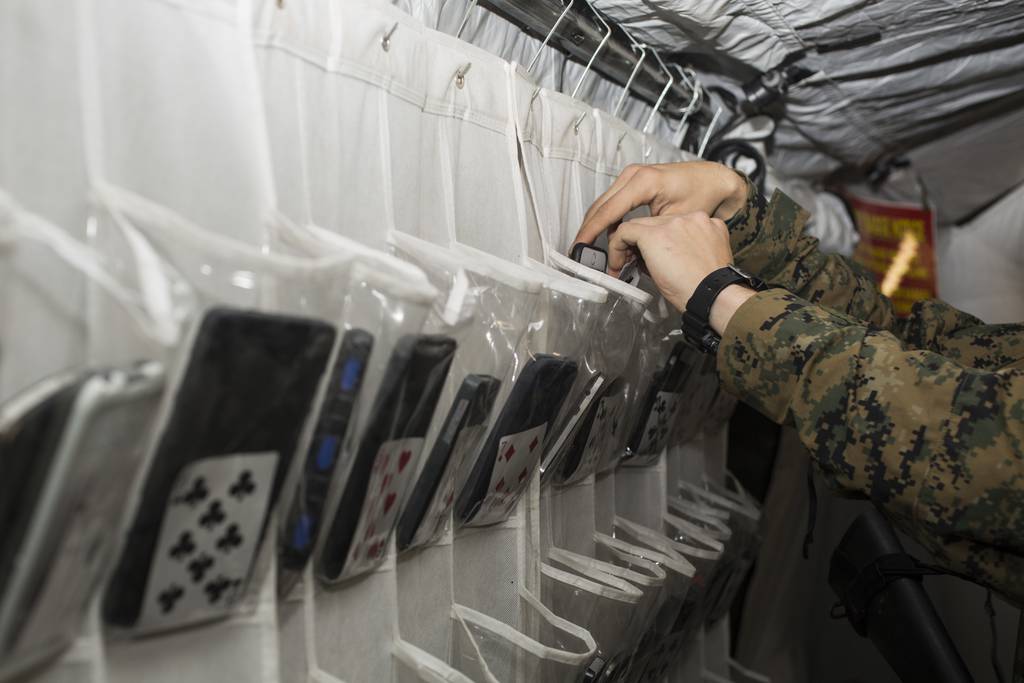A key goal of the Marine Corps’ overhaul oriented toward potential conflict with high-tech adversaries is to make the force less trackable, including by limiting troops’ use of personal cellphones. And that’s been no easy task, the top Marine officer said Wednesday.
Marine Commandant Gen. David Berger said at a Defense Writers Group event in Washington that Russia’s war in Ukraine has underscored the need for Marines to limit the electronic signature they emit through their personal devices. That’s especially hard for younger troops, he noted.
“Every time you press a button, you’re emitting,†Berger said. “Every Marine, every soldier, every sailor grows up with these now. They don’t think anything about pressing a button — this is what they do all day long.â€
“Now we have to completely undo 18 years of communicating all day long and tell them, ‘That’s bad, that will get you killed, so turn your cellphone off,’†he continued.
Berger didn’t provide specifics on the Corps’ cellphone policy during his brief discussion of the topic. But limiting an adversary’s ability to detect Marines’ positions has long been a Marine Corps priority.
The Corps has stressed counter-reconnaissance in recent years in response to the threat of precise, long-range weapons that can kill Marines at a distance if an adversary knows their positions. Force Design 2030, the overhaul of the Marine Corps that Berger has spearheaded since his earliest days as commandant, seeks to make the force more nimble and less easily traced.
Avoiding detection means distributing Marines into smaller groups. It means seeking out smaller, faster watercraft. And it means reducing the electronic signals that Marines emit ― not only through weapons and transport, but also through personal devices.
During the war in Ukraine, Russian soldiers’ use of unsecured cellphones continually has landed them in trouble. In one instance in the first few weeks of the war, Ukrainians killed a Russian general and his staff by intercepting his call, The New York Times reported.
But the U.S. military’s focus on the dangers that cellphones can pose to operational security predates Russia’s invasion of Ukraine in February.
When 3,500 paratrooper’s from the Army’s 82nd Airborne Division deployed to the Middle East in early 2020 amid rising tension with Iran, they had to leave their cellphones and laptops behind for operational security. Army officials stated at the time that the reason for the policy was to prevent the spread of sensitive information and to protect against Iranian cyberattacks.
The same month, a Marine lance corporal got his artillery unit fictitiously killed during a massive training exercise after posting a selfie of him being bored, allowing simulated adversaries to geolocate the unit, Military.com reported.
The II Marine Expeditionary Force commander at the time, Lt. Gen. Brian Beaudreault, said later in 2020 that Marine units would likely follow the 82nd’s lead in barring personal electronic devices on deployments.
The military in 2018 banned fitness-tracking apps for deployed troops after the app Strava released a heat map showing exercise routes that revealed the locations of sensitive overseas bases.
And in 2016, then-Commandant Gen. Robert Neller said cellphones left troops’ positions dangerously apparent during a Marine expeditionary force training exercise.
“What do you think the largest electromagnetic signature in the entire MEF headquarters emanated from? The billeting area,†he said. “Why? Because everybody had their phone on.â€
Irene Loewenson is a staff reporter for Marine Corps Times. She joined Military Times as an editorial fellow in August 2022. She is a graduate of Williams College, where she was the editor-in-chief of the student newspaper.








